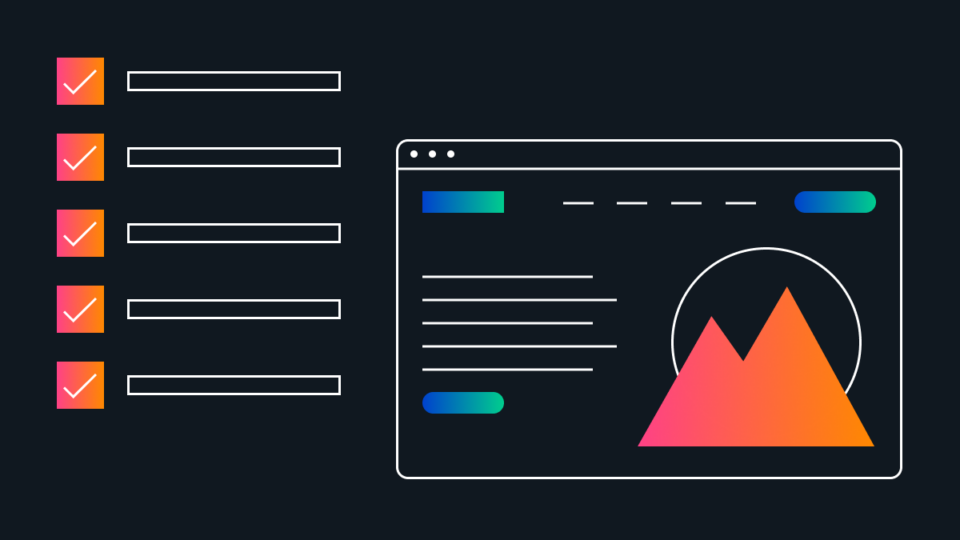Website audit checklist: 20 questions to ask before a website redesign

Rethink before you redesign
Website redesigns are a great opportunity to refine your business strategy with a fresh perspective.
They also bring up a lot of big questions like …
What’s our website’s greatest weakness? What’s our website’s greatest strength? What content should stay? What content should go?
Answering these questions requires a little detective work. When investing in a website redesign, you can’t afford to go on a hunch.
Inspect your website performance from header to footer, front-end to back-end. Use a website audit checklist to find performance clues across your website strategy, copy, design, and development.
“But isn’t that what we’re hiring a website agency for?”
Think of your internal website audit as a quick checkup. It’s an opportunity to gut-check your website redesign priorities before kicking off your collaboration with an agency.
Identifying your website’s gaps and opportunities will not only help you make more informed budget decisions, but it will also enable you to provide more insightful feedback to your copywriters, designers, and developers.
By becoming a more engaged client, you’ll build a closer partnership with your agency and end up with a more effective website that drives better results.
Tiller’s Website Audit Checklist guides you through 20 key questions across web strategy, copywriting, UX and UI design, and website development. Answer these questions before investing in a website redesign to enjoy a better return on your investment.
Website Strategy
1. Does your user journey help your audience find the information they need?
Make it easy for your target personas to navigate your website and absorb the information they need to make an informed buying decision. Remove all possible friction.
- Your sitemap is organized with a logical hierarchy of parent and child pages
- Your primary navigation includes links to the most important pages on your site
- Your primary navigation is focused and uncluttered, ideally with fewer than seven links
- Your menu labels are short and intuitive for your users based on solutions, use cases, or personas
- If your site includes multiple menus and a lot of links, you have a mega menu with headings and/or subheads to categorize the links
- Your primary CTA button(s) are easily visible in your top navigation bar
- Your users don’t have to choose between two or more competing primary CTAs
2. Are your target personas’ needs, interests, and pain points clear and up to date?
We’ve all heard the adage that if you try to appeal to everyone, you’ll appeal to no one. To attract, engage, and convert qualified leads, you must empathize with your target persona’s hyper-specific needs, interests, and pain points.
- Your target personas are clearly defined on your website
- Your persona’s needs, interests, and pain points are specific enough to resonate and drive action
- You include persona-specific case studies, use cases, or testimonials across the website
3. Have you clearly communicated what makes your product uniquely different from your competitors?
You have a short window to convince prospects of your value. What makes you special? What do you offer that your competitors can’t replicate?
- Your product feature differentiators focus on user benefits, desired outcomes, and pain relievers
- You position your product as the best possible solution to solve your audiences’ specific pain points
- Your brand voice and visuals stand out from your competitors
- You promote the team of people and culture behind your brand
- You prove impact by sharing measurable results
- You spotlight customer stories, use cases, or testimonials unique to your business
4. Are your website’s forms and lead capture tools optimized for conversion?
Your forms and lead capture tools gather information from potential leads that you can use to craft a more targeted and personalized pitch.
- You only include the most important fields on your lead capture form
- Your forms are responsive and mobile-friendly
- You address sales objections right on the page
- You reassure your buyer with solid social proof
5. Are you driving organic traffic with the right keywords?
Organic traffic typically has a higher engagement and conversion rate than direct traffic because it connects you to people already interested in your solution. It’s also more credible than running Search Engine Page Result (SERP) ads because it means that your top-of-page result was earned instead of bought.
- Your content is genuinely valuable to your target audience and designed to rank well for relevant keywords
- You aren’t cannibalizing your keywords by having multiple pages on your site compete for the same keyword
- You aren’t keyword stuffing by overusing the same keywords over and over to manipulate search rankings
- You strike the right balance between driving SEO value and optimizing your user experience on core product pages
- E.g. Instead of adding new core product pages to target new keywords, you create keyword-relevant content like blogs or white papers
- Your images are searchable via alternative text
- You regularly publish keyword-relevant content resources to boost your SERP ranking
Website Copy
6. Does your website back up key messaging with proof points or strong reasons to believe?
Your website copy should follow a key messaging framework that breaks your brand value into 3-5 concise statements. Each key message should be supported with benefits, reasons to believe, and social proof.
- Your website effectively distills your brand value into 3-5 key messages
- Each key message conveys one idea
- You support key messages with testimonials, indisputable truths, case studies, and stats to drive brand trust
- Your key messages are unique to your brand and differentiated from your competitors
- You use key messages to inform copy on your website not as copy on your website
Social proof can have a massive impact on conversion rates because people are more likely to follow the crowd than make decisions based on their own research.
Neil Patel
7. Are your headline and subheads value-driven?
A value-driven headline captures attention and conveys essential information to “skimmers”, those users who will only skim through your website copy to see if your product is valuable to them.
Your subheads and body text should add extra context. They should concisely explain what you offer, why it matters, and why it’s better than any other product or service they’re researching.
- Your copy follows the 4U Formula:
- It’s useful
- It’s unique
- It drives urgency
- It’s ultra-specific to your audience
- Your headlines are written in an active voice
- You prioritize conversational language over jargon
- Your headlines and subheads are customer-centric rather than company-centric
- Your subheads and body copy text compel readers to scroll further
- Every headline, subhead, or body copy text serves a specific purpose on the page
- You optimize page length to reduce scroll and cognitive overload
8. Are your CTA buttons driving qualified conversions?
At the end of the day, traffic and leads don’t bring in revenue. Conversions do. And conversions start with a call to action.
Even slightly changing your CTA button text or placement can significantly impact your conversion rate.
- Your CTAs invoke a sense of curiosity and urgency
- E.g. “Close More Deals Now”
- Your CTAs refer to one specific action
- E.g. “Show Me How To Close More Deals”
- Your CTAs are consistent across your website
- E.g. “Get a Demo” is not interchanged with “Book a Demo”
- Your CTA buttons are placed strategically on every conversion page
- E.g. Above the fold, mid-page, and at the bottom of the page
- Your CTA buttons are paired with engaging, conversational headlines that highlight an irresistible action
- E.g. “Ready To Close 68% More Deals?”
9. Does your copy promote product features through compelling benefits?
People don’t buy product features. They buy outcomes. Great copywriting shows your readers not only what your product can do, but the benefits and value it unlocks.
Your users aren’t interested in buying a “customer relationship management tool” or a “workflow automation platform” they want more confidence in their role or more time back in their day.
- You don’t just list product features; you tell a product story through tangible customer benefits, emotions, or outcomes
- The benefits promised are easily understood and relatable to your audience
- You backup your feature’s benefits with real customer use cases and testimonials
10. Does your website copy consistently communicate in a specific tone of voice?
Your brand voice is the feeling or attitude that comes from your editorial style and word choice.
Defining and protecting a common tone of voice helps your customers distinguish your brand in a sea of software sameness.
- Your headlines, subheads, and body copy text are consistent with your brand voice
- E.g. If your brand voice is bold, are you using concise, authoritative language, punchy headlines, and clearly calling your strengths?
- E.g. If your brand voice is lighthearted, are you using conversational, somewhat playful language, and limiting corporate jargon?
- Your website copy sits on a tone spectrum
- E.g. “Confident but not arrogant” or “Encouraging but not overbearing”
Website UI & UX Design
11. Is your branding consistent throughout your website?
Consistent branding helps to establish two essential drivers in the buying decision: brand recall and brand trust.
- Your brand elements like colours, logos, fonts, illustrations, and patterns are used consistently throughout your website
- Your brand voice is consistent across all copy
- Your casing (headlines, labels, titles, etc.) follows a clear pattern
- Your headline, subhead, and body text formatting is consistent across the site
12. Does your design put your brand ahead above your competitors?
Visual identity is critical for both first impressions and memorability. If your product is very similar to other SaaS offerings, visual differentiation can help keep your brand top of mind.
- Your colour palette, font, and image style differ from your competitors
- All the elements of your UI design come together to communicate a distinct brand personality
- You incorporate interactive design elements, micro-interactions, or animation to surprise and delight your audience
13. Do you effectively showcase your product with a video or screenshots?
A B2B SaaS website without product screenshots or product videos is like a McDonald’s commercial without a burger. You can describe your product all you want; people won’t buy what they can’t see.
- You showcase your product or platform’s latest UI design with high-quality graphics
- You paired product screenshots with relevant copy
- You use copy and design to highlight important features and communicate how they work
- You add brand design, graphic overlay, or interactive design elements to make your product illustrations more engaging and understandable
14. Does your site meet Web Content Accessibility Guidelines (WCAG)?
The WCAG outlines international standards for web content accessibility to help you adhere to and improve your:
- Legal Compliance
- Inclusivity
- User Experience
- Ethical Responsibility
Begin your accessibility audit here.
15. Does your site follow design best practices (heuristics)?
Heuristics are best practices or rules of thumb that guide design decisions to create a user-friendly and intuitive web experience.
Heuristic violations hurt your user experience. They confuse and frustrate your users, often leading to a lack of trust in your brand and lower engagement with your site.
- Users have the option to exit your website to leave an unwanted action
- Your website prevents errors from happening with confirmation options
- Your CTA buttons use high-contrast colours for easy visibility
- Your website’s visual design supports the user’s primary goals with a minimalist design and adequate whitespace
- Your website helps users easily recognize, diagnose, and recover from errors with plain-spoken language and cues
Website Development
16. How easy is it to modify or reuse your website components as you grow? Is your code scaleable?
Code scalability is your website’s ability to handle increasing work or data without a significant decrease in performance or an increase in errors.
Scalable code allows you to easily add, change, edit, and revamp your website content as you grow. If your website code is not scalable, any increase in demand may require significant rework or even a complete rewrite.
- You have the ability to add more servers or resources to your website as needed
- Your website code is modular, meaning you can easily add new content and pages
- Your website’s back-end codebase is relatively easy to modify and scale as website traffic increases
17. Is your site responsive on mobile, tablet, and desktop?
In 2023, building a mobile-friendly website is non-negotiable.
If your website isn’t mobile-friendly, it not only provides a frustrating experience for your users, it can destroy your SEO value. Google and other search engines consider mobile-friendliness a key factor in their ranking algorithm.
- Your website displays well on various mobile devices with different screen sizes and resolutions
- Your website’s features and functionality work well on mobile devices, including menus, forms, and buttons
- Your website content can be read on mobile devices without requiring users to zoom or pinch the screen
18. Does your website integrate well with the rest of your martech stack?
Your website should complement and support your other marketing and sales efforts and streamline communication across your organization. Your website should make it easier, not harder to collect, organize, and share customer data.
- Your website uses APIs or webhooks to connect with your other marketing tools
- Data captured on your website is easily stored and shared with your other marketing tools or platforms
19. Are your web pages properly indexed in Google?
Fixing technical issues will not only improve your user experience and website credibility, but it will also help improve how Google indexes and promotes your site on the SERP.
- You stay on top of technical issues such as broken links, server, or crawl errors
- Your metadata (title tags and meta descriptions) effectively summarize your website content
- Your website has little to no duplicate content
20. Is your load speed costing you visitors?
A 2019 study by Marketing Firm, Protent, found that B2B websites that load in 1 second have 3x higher conversion rates than sites that load in 5 seconds.
- Your website is free of faulty redirects
- Your website runs on a performance-optimized hosting solution
- You compress your website images and other media to optimize file size
- You actively eliminate unnecessary plugins
- Your loading pages provide interesting microcopy or imagery to keep visitors engaged while they wait
Now what?
A website redesign requires internal alignment and strategic decision-making. To make the most of your investment you must start by asking and answering the right questions.
Once you understand where your website’s gaps and opportunities lie, you’re ready to begin the work. Lean on an agency partner like Tiller to guide you through a website redesign from audit to launch.


